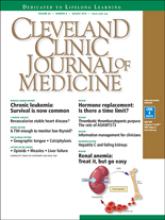Article Figures & Data
Tables
Authors Study description Risk of coronary heart diseasea Salpeter et al13 Meta-analysis of 23 randomized controlled trials in 39,049 postmenopausal women
Mean duration of follow-up 4.8 years
Excludes Women’s Health Initiative trial data
Estrogen formulations include conju-gated equine estrogen (CEE) and ethinyl estradiol
Progesterone formulations include medroxyprogesterone acetate (MPA), gestodene, and micronized progesteroneSubgroup Odds ratio 95% CI Within 10 years of menopause and age < 60 0.68 0.48-0.96 > 10 years of menopause and age > 60 1.03 0.91–1.16 First year of hormone therapy and age < 60 0.22 1.12–1.92 First year of hormone therapy and age > 60 1.47 0.67–0.93 Overall 0.99 0.88–1.11 Rossouw et al14 Secondary analysis of Women’s Health Initiative, 27,347 US postmenopausal women
Average age 64
Average time since menopause 12 years
Intervention hormone therapies: CEE 0.625 mg/day or CEE + MPA 2.5 mg/daySubgroup Hazard ratio 95% CI Within 10 years of menopause 0.76 0.50–1.16 10–19 years since menopause 1.10 0.84–1.45 > 20 years since menopause 1.28 1.03–1.58 Age 50–59 0.93 0.65–1.33 Age 60–69 0.98 0.79–1.21 Age > 70 1.26 1.00–1.59 Overall 1.07 0.92–1.23 Schierbeck et al15 Danish Osteoporosis Study, 1,006 post-menopausal women
Average age 50
Average time since menopause 7 months
Intervention hormone therapy: 17-beta estradiol (BE) 2 mg/day or 17BE + norethisterone acetate 1 mg/day
Composite end point includes heart fail-ure, cardiovascular death, and nonfatal myocardial infarctionAnalysis Hazard ratio 95% CI 11 years of hormone therapy 0.48 0.26–0.87 16-year follow-up 0.61 0.39–0.94 ↵a Cardiovascular death and nonfatal myocardial infarction.
CI = confidence interval
Contraindications. In general, estrogen therapy should not be used in women with any of the following conditions: Undiagnosed abnormal genital bleeding Known, suspected, or history of cancer of the breast Known or suspected estrogen-dependent neoplasia including endometrial cancer Active deep vein thrombosis, pulmonary embolism, or history of these conditions Active arterial thromboembolic disease (for example, stroke, myocardial infarction) or a history of these conditions Known anaphylactic reaction or angioedema in response to any ingredient in the medication Known liver impairment or disease Known protein C, protein S, or antithrombin deficiency, or other known thrombophilic disorders Known or suspected pregnancy Caution should also be exercised in women with: Gallbladder disease (oral estrogen therapy) Hypertriglyceridemia (> 400 mg/day) (oral estrogen therapy) Diabetes Hypoparathyroidism (risk of hypocalcemia) Benign meningioma Intermediate or high risk of breast cancer High risk of heart disease Migraine with aura (can be used, but may exacerbate condition) Asthma (rare chance of exacerbation) Epilepsy Porphyria Systemic lupus erythematosus Hepatic hemangioma Based on information in reference 3.
Ultra-low dose Low dose Standard dose High dose Oral formulations Conjugated estrogen Not available (NA) 0.3, 0.45 mg 0.625 mg 0.9, 1.25 mg Esterified estrogen NA 0.3 mg 0.625 mg 1.25, 2.5 mg Estropipate NA NA 0.75, 1.5 mg 3 mg Estradiol acetate NA 0.45 mg 0.9 mg 1.8 mg 17-beta estradiol 0.25 mg 0.5 mg 1, 2 mg NA Topical formulations Estradiol patch 0.014 mg/day (14 μg/day) 0.025 mg/day 0.0375, 0.05 mg/day 0.06, 0.075, 0.1 mg/day Gels, pumps, sprays Various brands of estr adiol available in all dosing options Vaginal formulation Femringa NA NA 0.05 mg/day 1 mg/day ↵a Femring is the only vaginal formulation in the United States that provides standard/high-dose systemic levels of estrogen. All other vaginal estrogen formulations are indicated to treat only the genitourinary symptoms of menopause through local vaginal effects.






